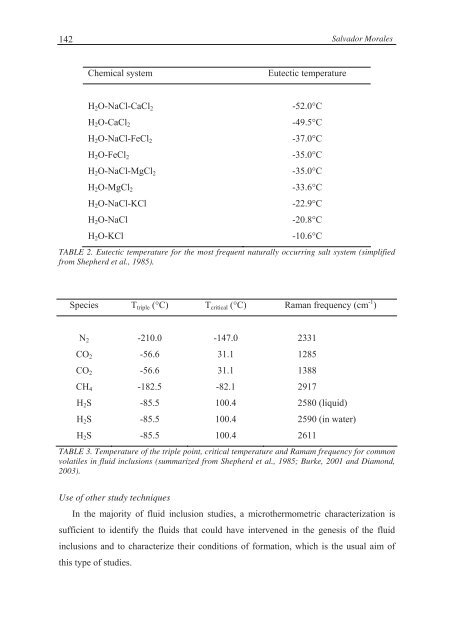instrumental techniques applied to mineralogy and geochemistry
instrumental techniques applied to mineralogy and geochemistry
instrumental techniques applied to mineralogy and geochemistry
Create successful ePaper yourself
Turn your PDF publications into a flip-book with our unique Google optimized e-Paper software.
142<br />
Salvador Morales<br />
Chemical system<br />
Eutectic temperature<br />
H 2 O-NaCl-CaCl 2<br />
H 2 O-CaCl 2<br />
H 2 O-NaCl-FeCl 2<br />
H 2 O-FeCl 2<br />
H 2 O-NaCl-MgCl 2<br />
H 2 O-MgCl 2<br />
H 2 O-NaCl-KCl<br />
H 2 O-NaCl<br />
H 2 O-KCl<br />
-52.0°C<br />
-49.5°C<br />
-37.0°C<br />
-35.0°C<br />
-35.0°C<br />
-33.6°C<br />
-22.9°C<br />
-20.8°C<br />
-10.6°C<br />
TABLE 2. Eutectic temperature for the most frequent naturally occurring salt system (simplified<br />
from Shepherd et al., 1985).<br />
Species T triple (°C) T critical (°C) Raman frequency (cm -1 )<br />
N 2 -210.0 -147.0 2331<br />
CO 2 -56.6 31.1 1285<br />
CO 2 -56.6 31.1 1388<br />
CH 4 -182.5 -82.1 2917<br />
H 2 S -85.5 100.4 2580 (liquid)<br />
H 2 S -85.5 100.4 2590 (in water)<br />
H 2 S -85.5 100.4 2611<br />
TABLE 3. Temperature of the triple point, critical temperature <strong>and</strong> Ramam frequency for common<br />
volatiles in fluid inclusions (summarized from Shepherd et al., 1985; Burke, 2001 <strong>and</strong> Diamond,<br />
2003).<br />
Use of other study <strong>techniques</strong><br />
In the majority of fluid inclusion studies, a microthermometric characterization is<br />
sufficient <strong>to</strong> identify the fluids that could have intervened in the genesis of the fluid<br />
inclusions <strong>and</strong> <strong>to</strong> characterize their conditions of formation, which is the usual aim of<br />
this type of studies.













